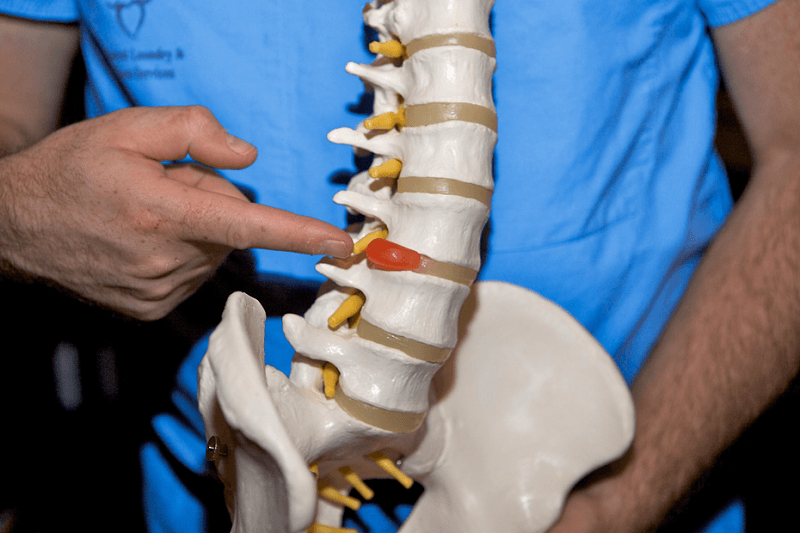A bulging disc in the neck refers to a condition where the cushion-like discs that separate the vertebrae in the neck push out or bulge, putting pressure on the surrounding nerves. This can result in pain, numbness, weakness, or tingling in the neck, shoulders, arms, or hands.
There are several treatment options available to help alleviate the symptoms and fix a bulging disc in the neck. Non-surgical methods are often attempted first, and these include rest, physical therapy, pain medications, and anti-inflammatory drugs. Physical therapy may involve exercises to improve neck strength and flexibility, as well as techniques to correct posture and relieve pressure on the affected area.
In more severe cases or if non-surgical methods fail to provide relief, surgery may be considered. The specific surgical procedure depends on the severity and location of the disc bulge. One common surgery is discectomy, where the protruding portion of the disc is removed to relieve pressure on the nerves. Another procedure, called spinal fusion, involves fusing the adjacent vertebrae to stabilize the spine.
Advancements in medical technology have also introduced minimally invasive procedures for treating bulging discs. These procedures use small incisions and specialized tools to access and repair the disc, resulting in shorter recovery times and less post-operative pain.
However, it is important to note that each case is unique, and the appropriate treatment plan varies from person to person. Consulting with a healthcare professional is crucial to ensure an accurate diagnosis and the most effective treatment approach.
In conclusion, treating a bulging disc in the neck may involve non-surgical methods such as rest, physical therapy, and medication. In more severe cases, surgery may be considered, including procedures like discectomy or spinal fusion. Minimally invasive techniques are also available. A tailored treatment plan should be discussed with a healthcare professional to determine the best course of action for each individual.
What does a bulging disc in neck feel like?
Pain when moving your neck or deep pain near or over the shoulder blade. You may also feel pain that moves to the upper arm, forearm, and fingers and numbness along your shoulder, elbow, forearm, and fingers. These are common symptoms when you have a slipped disc in your neck.
Can you physically feel a bulging disc?
If you have a bulging spinal disc, you may be wondering if you can physically feel it. You are not likely to be able to feel the disc itself, since it is located between the bones of your spine. However, you may be able to determine the affected area by touching various points along your back that you can reach.Dec 9, 2022
What’s the worst that can happen with a bulging disc?
If the repeated forward bending stress continues, or the improper body mechanics continue, very often the inner disc material will continue to push backwards, causing the disc bulgedisc bulgeA disc protrusion is a medical condition that can occur in some vertebrates, including humans, in which the outermost layers of the anulus fibrosus of the intervertebral discs of the spine are intact but bulge when one or more of the discs are under pressure.https://en.wikipedia.org › wiki › Disc_protrusionDisc protrusion – Wikipedia to worsen, to herniate, progressing into the spinal canal and towards the spinal cord.
How does a bulging disc make you feel?
Symptoms from a bulging disc come on slowly over time. You may have neck or back pain, with tingling, numbness or weakness in your arms, hands, legs or feet.

How do I know if I tore my ACL or MCL?
It can be easy to confuse the two injuries, as both a torn ACL and a torn MCL exhibits similar symptoms, including: swelling, inflammation, extreme pain and possible bruising. The main difference between an ACL tear and an MCL tear is that an ACL tear will have a distinctive popping sound, while an MCL tear will not.
How can I tell if my MCL is torn?
What are MCL tear symptoms? The most noticeable MCL tear symptom is pain on the inside of your knee directly over the ligament. You may also hear and feel a “popping” sensation in your knee at the time of injury. Other common symptoms include bruising, knee instability, swelling, and the inability to hold your weight.
Can you tear your MCL and still walk?
Can you still walk with a torn MCL? If you have a grade 1 (minor) MCL tear, you’ll likely still be able to walk at the time of the injury, though it might be painful. A grade 2 (moderate) MCL tear could make it difficult to walk at the time of the injury since your knee won’t be as stable as it normally is.
Is an ACL or MCL tear worse?
While not always the case, an ACL tear is in most cases going to be the more severe injury. It is considered worse than tearing the MCL because ACL tears are in general more complex to treat and require a longer recovery time after surgery.
What does a Grade 1 MCL sprain feel like?
Grade 1 — Some tenderness and minor pain. Grade 2 — Noticeable looseness in the knee when moved by hand; major pain and tenderness at the inside of the knee; swelling, in some cases. Grade 3 — Considerable pain and tenderness at the inside of the knee; some swelling and marked joint instability.



